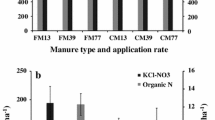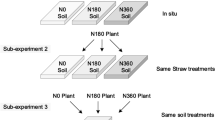Summary
The mass loss and N dynamics of barley stems and leaves, placed on the soil surface or buried, were examined over two summers. There was little difference in mass loss or N dynamics in straw placed 7.5 or 15 cm deep. However, the surface straw lost mass much more slowly and immobilized more N for a longer time than the buried straw. Filter paper had a slow rate of mass loss initially, but once started, lost mass much more rapidly than either the barley stems or leaves. Loss of mass was closely correlated with the cellulose loss in straw, whether buried or placed on the soil surface. The sustained rate of mass loss was 6.3 and 7.0% month-1, respectively, for surface and incorporated leaves compared with 3.5 and 4.3% month-1, for surface and incorporated stems. The greater loss sustained by the leaves was attributed to a lower lignin content rather than a higher N content, because the addition of N to the straw after 30 days in the field failed to increase CO2 evolution. Maximum net N immobilization occurred within 30 days for all the barley straw, except for the stems placed on the ground surface, which did not reach maximum N immobilization until the second summer. Immobilization and mineralization of N were estimated for a 3000 kg ha-1 grain crop. Surface straw immobilized 3.8 kg N ha-1 in the 1st year and 9 kg N ha-1 in the 2nd year, whereas incorporated straw immobilixed 3.5 kg N hs-1 in the 1st year and mineralized 4.5 kg N ha-1 in the 2nd year. Thus, in Alaska, residue management does not affect N fertilizer requirements in the 1st year, but an additional 13.5 kg N ha-1 is required for surface residues in the 2nd year.
Similar content being viewed by others
References
Allmaras RR, Douglas CL Jr, Rasmussen PE, Baastad LL (1985) Distribution of small grains residue produced by combines. Agron J 77:730–734
Bignell DE (1989) Relative assimilations of 14C labeled microbial tissue and 14C-plant fibre ingested with leaf litter by the millipede (Glomeris marginata) under experimental conditions. Soil Biol Biochem 21:819–827
Brown PL, Dickey DV (1970) Losses of wheat straw residue and simulated fie field conditions. Soil Sci Soc Am Proc 34:118–121
Christensen BT (1985) Decomposability of barley straw: Effect of cold-water extraction on dry weight and nutrient content. Soil Biol Biochem 17:93–97
Christensen BT (1986) Barley straw decomposition under field conditions: Effect of placement and initial nitrogen content on weight loss and nitrogen dynamics. Soil Biol Biochem 18:523–529
Cochran VL, Horton KA, Cole CV (1988) An estimation of microbial death rate and limitations of N or C during wheat straw decomposition. Soil Biol Biochem 20:293–298
Cochran VL, Elliott LF, Lewis CE (1989) Soil microbial biomass and enzyme activity in subarctic agricultural and forest soils. Biol Fertil Soils 7:283–288
Collins HP, Elliott LF (1991) Cellulose activity and microbial numbers associated with wheat residue decomposition. Soil Biol Biochem (in press)
Connetta AA, Buccafuci A, Jansen J (1976) A semi-automatic system for the wet digestion of water samples for total Kjeldahl N and P. Am Lab 8:103–106
Douglas CL, Allmaras RR, Rasmussen PE, Ramig RE, Roager NC (1980) Wheat straw composition and placement effects on decomposition in dry land agriculture of the Pacific Northwest. Soil Sci Soc Am J 44:833–837
Edwards NT (1982) The use of soda-lime for measuring respiration rates in terrestrial systems. Pedobiologia 28:321–330
Fox JD (1977) Interactions of grain production and water resources: Hydrologic considerations. In: Murray M (ed) Expanding agriculture and management of interior Alaska resources. School of Agriculture and Land Resources Management, Univ of Alaska, Fairbanks, Alaska, pp 77–93
Goering HK, Van Soest PJ (1970) Forage fiber analysis. USDA Agric Handbook No 379, USDA-ARS, Washington DC
Harper SHT, Lynch JM (1981) The chemical components and decomposition of wheat straw leaves, internodes, and nodes. J Sci Food Agric 32:1057–1062
Herman WA, McGill WB, Dormar JF (1977) Effects of initial chemical composition on decomposition of roots of three grass species. Can J Soil Sci 57:205–215
House GJ, Stinner BJ, Grossley DA Jr, Odum EP, Langdale GW (1984) Nitrogen cycling in conventional and no-tillage agroecosystems in the southern Piedmont: J Soil Water Conserv 39:194–200
Knapp EB, Elliott LF, Campbell GS (1983) Microbial respiration and growth during the decomposition of wheat straw. Soil Biol Biochem 15:319–323
Lewis CE, Cullum RF (1985) Crop residue management in interior Alaska. In: Straw Management Symposium Proceedìngs. Great Plains Agricultural Council, Agriculture Canada, Swift Current, Saskatchewan, pp 395–409
Lewis CE, Thomas WG (1982) Expanding subarctic agriculture: Social, political, and economic aspects in Alaska. Interdiscipl Sci Rev 7:178–187
Parker DT (1962) Decomposition in the field of buried and surface-applied cornstalk residues. Soil Sci Soc Am Proc 26:559–562
Parr JF, Papendick RI (1978) Factors affecting the decomposition of crop residues by microorganisms. In: Oschwald WR (ed) Crop residue management systems. ASA, CSA, Soil Sci Soc Am, Madison, Wisconsin
Reinertsen SA, Elliott LF, Cochran VL, Campbell GS (1984) Role of available carbon and nitrogen in determining the rate of wheat straw decomposition. Soil Biol Biochem 16:459–464
Sain P, Broadbent FE (1977) Decomposition of rice straw in soils as affected by some management factors. J Environ Qual 6:96–100
Samedov PA (1988) Significance of soil invertebrates in decomposition of plant remains and humus formation in meadow sierozem soils. Pochvovedenie 8:109–114
Smith JH, Douglas CL (1971) Wheat straw decomposition in the field. Soil Sci Soc Am Proc 35:269–272
Stott DE, Kassim GH, Farrell WM, Martin JP, Haider K (1983) Stabilization and incorporation into biomass of specific plant carbons having biodegradation. Plant and Soil 70:15–26
Stott DE, Stroo HF, Elliott LF, Papendick RI, Unger PW (1990) Wheat residue loss from fields under no-till management. Soil Sci Soc Am J 54:92–98
Stroo HF, Bristow KL, Elliott LF, Papendick RI, Campbell GS (1989) Predicting rates of wheat residue decomposition. Soil Sci Soc Am J 53:91–99
Summerell BA, Burgess LW (1989) Decomposition and chemical composition of cereal straw. Soil Biol Biochem 21:551–559
Wessen B, Berg B (1986) Long-term decomposition of barley straw: Chemical changes and ingrowth of fungal mycelium. Soil Biol Biochem 18:53–59
Author information
Authors and Affiliations
Rights and permissions
About this article
Cite this article
Cochran, V.L. Decomposition of barley straw in a subarctic soil in the field. Biol Fert Soils 10, 227–232 (1991). https://doi.org/10.1007/BF00337372
Received:
Issue Date:
DOI: https://doi.org/10.1007/BF00337372




